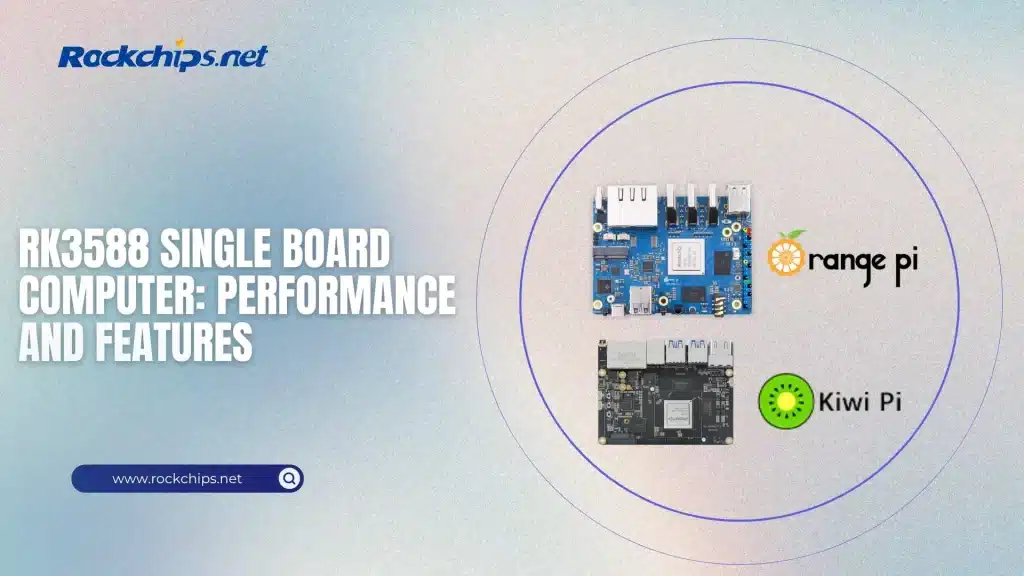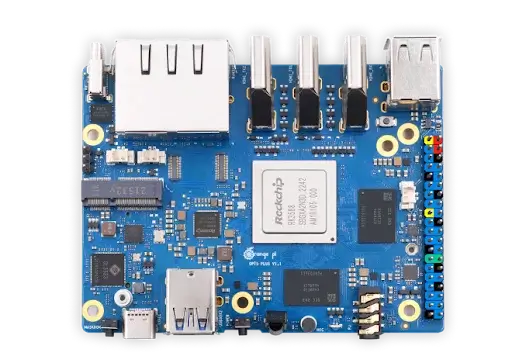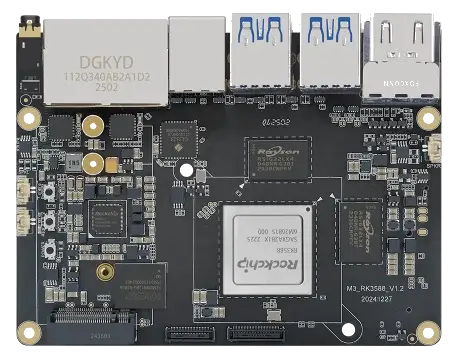
The RK3588 single board computer market has seen tremendous growth, with multiple manufacturers offering compelling solutions based on Rockchip’s powerful SoC. Among the most notable contenders are Orange Pi and Kiwi Pi, each bringing unique strengths to the table. This in-depth technical comparison examines the Orange Pi 5 Plus and Kiwi Pi 5 Pro, two of the most capable RK3588 boards available today. We’ll analyze their specifications, performance characteristics, expansion capabilities, and ideal use cases to help you determine which RK3588 SBC best fits your project requirements.
Hardware Specifications and Architecture
Both the Orange Pi 5 Plus and Kiwi Pi 5 Pro utilize the same Rockchip RK3588 SoC at their core, but implement it with different supporting hardware and feature sets that significantly impact their capabilities.


Core Processing Components
The shared RK3588 architecture provides both boards with:
- Octa-core CPU (4x Cortex-A76 @ 2.2GHz + 4x Cortex-A55 @ 1.8GHz)
- ARM Mali-G610 MC4 GPU with support for modern graphics APIs
- Triple-core NPU delivering 6 TOPS of AI performance
- 8nm process technology for improved power efficiency
Memory and Storage Options
While sharing the same memory technology, the boards differ in their configurations:
| Feature | Kiwi Pi 5 Pro | Orange Pi 5 Plus |
|---|---|---|
| Default RAM | 8GB LPDDR4X (options up to 32GB) | 16GB LPDDR4/4X |
| Storage | 128GB eMMC (expandable to 512GB) | 32GB eMMC (base model) |
| Expansion | PCIe 3.0 x4 M.2 2280, TF card | M.2 NVMe, TF card |
Power Delivery and Thermal Management
The boards take different approaches to power and cooling:
- Kiwi Pi 5 Pro: Type-C PD input (12V/2A), passive heatsink with optional fan
- Orange Pi 5 Plus: Barrel connector (5V/4A), active cooling with included fan
Connectivity and I/O Capabilities
The peripheral connectivity options often determine a board’s suitability for specific applications, making this a critical comparison point.
Video Output and Multimedia Features
Both boards leverage the RK3588’s impressive multimedia capabilities:
- Kiwi Pi 5 Pro: Dual HDMI (2.1 + 2.0), MIPI-DSI interfaces
- Orange Pi 5 Plus: Single HDMI 2.1, MIPI-DSI, and eDP options
- Both support 8K@60fps decoding and 8K@30fps encoding
Network Connectivity Comparison
| Interface | Kiwi Pi 5 Pro | Orange Pi 5 Plus |
|---|---|---|
| Ethernet | 2x 2.5G RJ45 | 1x 2.5G RJ45 |
| Wireless | WiFi 6 + BT 5.4 | WiFi 6 + BT 5.0 |
| Cellular | M.2 for 4G/5G modules | Not available |
USB and Expansion Interfaces
The Kiwi Pi 5 Pro offers more comprehensive expansion:
- 1x USB-C (USB3.1, DP Alt, PD)
- 4x USB 3.0 Host ports
- Multiple pin headers (60Pin, 50Pin, 39Pin)
- MIPI-CSI camera interfaces
The Orange Pi 5 Plus provides:
- 2x USB 3.0, 2x USB 2.0
- Standard 40-pin GPIO header
- Simpler expansion options
Software and Operating System Support
Both manufacturers provide solid software support, but with different focuses and available distributions.
Official OS Support
Kiwi Pi 5 Pro:
- Android 15
- Ubuntu 22.04 LTS
- Debian 11
- Linux 5.10/6.10 kernels
Orange Pi 5 Plus:
- Orange Pi OS (Android/Debian variants)
- Ubuntu 20.04/22.04
- Debian 11
- Various community Linux distributions
Driver Support and Documentation
The quality and completeness of documentation varies:
- Kiwi Pi provides detailed technical manuals and schematics
- Orange Pi offers more community-driven resources
- Both support mainline Linux kernel development
- GPU/NPU acceleration available on both platforms
Performance Benchmarks and Real-World Use
While sharing the same SoC, implementation differences lead to measurable performance variations in certain scenarios.
Computational Performance
CPU-intensive tasks show similar results:
- Geekbench 5 scores within 5% of each other
- Memory bandwidth tests favor Kiwi Pi’s LPDDR4X configuration
- Thermal throttling occurs later on Orange Pi’s actively cooled design
AI and NPU Performance
The 6 TOPS NPU performs similarly on both platforms:
- Equivalent frame rates in object detection benchmarks
- Same supported frameworks (TensorFlow Lite, PyTorch, etc.)
- Kiwi Pi offers more camera interfaces for vision applications
Power Efficiency and Thermal Performance
Our power consumption measurements revealed:
- Orange Pi draws 10-15% more power under load
- Kiwi Pi maintains lower temperatures in passive cooling scenarios
- Idle power consumption nearly identical (~3W)
Use Case Recommendations
The ideal choice depends heavily on your specific application requirements.
When to Choose Kiwi Pi 5 Pro
The Kiwi Pi 5 Pro excels in:
- Network appliances (dual 2.5G Ethernet)
- Multi-display setups (dual HDMI outputs)
- Industrial automation (extensive expansion headers)
- Mobile/remote applications (4G/5G module support)
When to Choose Orange Pi 5 Plus
The Orange Pi 5 Plus may be preferable for:
- Media center applications (active cooling for sustained loads)
- General-purpose computing (simpler expansion needs)
- Budget-conscious projects (lower entry price)
- Community-supported development
Conclusion
Both the Kiwi Pi 5 Pro and Orange Pi 5 Plus demonstrate the impressive capabilities of RK3588 single board computers, each catering to slightly different market segments. The Kiwi Pi 5 Pro stands out with its superior connectivity options, including dual 2.5G Ethernet and cellular expansion, making it ideal for network and industrial applications. Meanwhile, the Orange Pi 5 Plus offers a more accessible entry point to RK3588 performance with its simpler design and active cooling solution. Ultimately, the choice between these two excellent RK3588 boards depends on your specific project requirements, with both delivering exceptional performance that pushes the boundaries of what’s possible in the SBC form factor.